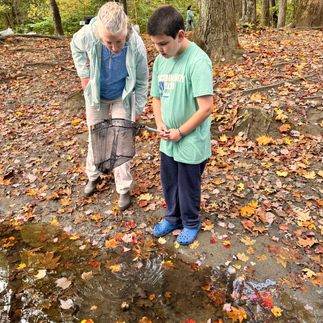Mill River Field Trip
On a windy October field trip to the Mill River with Connecticut River Conservancy’s Ryan O’Donnell, third graders got their feet wet, learned about river health, and scooped up wriggling creatures. Students in Cindy Kassell’s 3rd grade at Lander-Grinspoon Academy in Northampton, MA are studying the Connecticut River and the Mill River. Their year-long study investigates, “How have these rivers been significant to the people in the valley? How do we care for rivers?” Kassell reached out to CRC: “my class would love to learn more about the river and help protect it… we want to get involved in the local river happenings.”

Is it clean?
Ryan O’Donnell, CRC’s Monitoring Program Manager, showed students the sign posted on a tree next to the river: Is it Clean/Esta Limpio? “I made that sign and put it there!” He explained his job and the role of volunteer monitors who collect water samples to test in the lab. “There are lots of things we can do to understand rivers and different ways to tell if a river is healthy.” Students got very excited when he waded into the shallow water with a kick-net, showing them how to sample macroinvertebrates to assess the level of pollution in a stream.
Who’s living in the river?
Children eagerly explored the leaf-filled shallow water with little nets, scooping their findings into containers to examine up close. They observed tiny fish, hopping beetles, and bubbles coming up from the leafy sediment. “There’s a cute little frog! Two frogs! Hopping away!” O’Donnell brought their attention to a big crayfish lurking in the fork of a tree root, telling them to approach quietly so it wouldn’t scoot away. Everyone got a good look – “it’s huge!!” – and learned that crayfish belong to the category of organisms considered moderately pollution tolerant. Children’s favorite part of getting out of the river was dumping their boots to see who had collected the most water.
Writing weathergrams
“Who wants to write a note to the river?” Carol Berner, River of Words Regional Coordinator, gathered students in a circle and showed them how to make weathergrams. She invited them to write a few words capturing the “here and now” of this place and moment. Students suggested sensory observations: “drops of rain falling off the trees, leaves moving slowly downstream, a dog splashing.” Berner gave them each a strip of brown paper tied with twine to write their message and hang it from a branch – so the weather could write back. As soon as the children settled quietly into writing, a sudden gust of wind blew acorns into the water, making loud pops and splashes. Children exclaimed that the weather was already writing back!
Walking back from the river to the trailhead, carrying nets and wet boots, children talked happily about all the things they had seen and heard and learned on their field trip to the Mill River.
Weathergram
The wind
blows the
acorns in
the water
and makes
a sound like
plip plip plop plop
I found a lot
of fish and
a lot of crayfish
and when nature
blows it makes
me happy.
















